Configure Microsoft CA Server to Publish the Certificate Revocation Lists for ISE
Available Languages
Download Options
Bias-Free Language
The documentation set for this product strives to use bias-free language. For the purposes of this documentation set, bias-free is defined as language that does not imply discrimination based on age, disability, gender, racial identity, ethnic identity, sexual orientation, socioeconomic status, and intersectionality. Exceptions may be present in the documentation due to language that is hardcoded in the user interfaces of the product software, language used based on RFP documentation, or language that is used by a referenced third-party product. Learn more about how Cisco is using Inclusive Language.
Contents
Introduction
This document describes the configuration of a Microsoft Certificate Authority (CA) server that runs Internet Information Services (IIS) to publish the Certificate Revocation List (CRL) updates. It also explains how to configure the Cisco Identity Services Engine (ISE) (versions 3.0 and later) to retrieve the updates for use in certificate validation. ISE can be configured to retrieve CRLs for the various CA root certificates it uses in certificate validation.
Prerequisite
Requirements
There are no specific requirements for this document.
Components Used
The information in this document is based on these software and hardware versions:
-
Cisco Identity Services Engine Release 3.0
-
Microsoft Windows® Server® 2008 R2
The information in this document was created from the devices in a specific lab environment. All of the devices used in this document started with a cleared (default) configuration. If your network is live, ensure that you understand the potential impact of any command.
Configure
In this section, you are presented with the information to configure the features described in this document.
Create and Configure a Folder on the CA to House the CRL Files
The first task is to configure a location on the CA server to store the CRL files. By default, the Microsoft CA server publishes the files to C:\Windows\system32\CertSrv\CertEnroll\
Rather than use this system folder, create a new folder for the files.
- On the IIS server, choose a location on the file system and create a new folder. In this example, the folder C:\CRLDistribution is created.
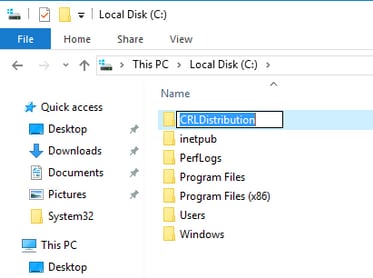
2. In order for the CA to write the CRL files to the new folder, sharing must be enabled. Right-click the new folder, choose Properties, click the Sharing tab, and then click Advanced Sharing.

3. In order to share the folder, check the Share this folder check box and then add a dollar sign ($) to the end of the share name in the Share name field to hide the share.

4. Click Permissions (1), click Add (2), click Object Types (3), and check the Computers check box (4).
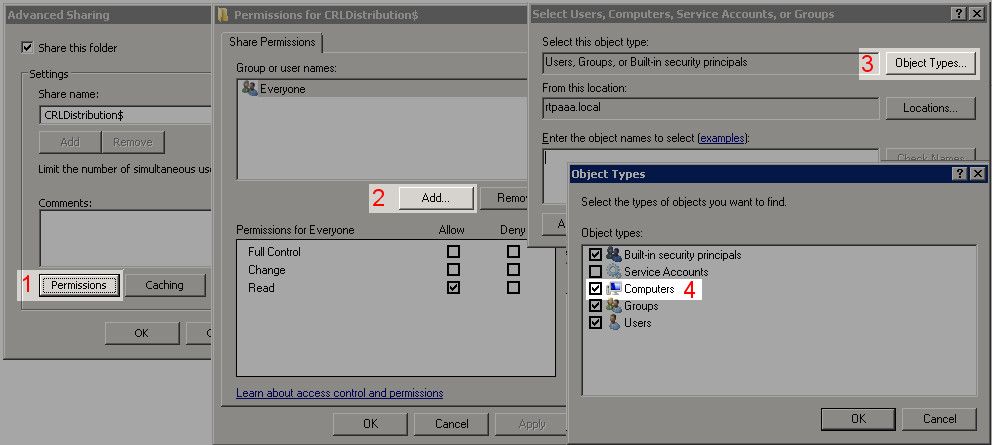
5. In order to return to the Select Users, Computers, Service Accounts, or Groups window, click OK. In the Enter the object names to select field, enter the computer name of the CA server in this example: WIN0231PNBS4IPH and click Check Names. If the name entered is valid, the name refreshes and appears underlined. Click OK.

6. In the Group or user names field, choose the CA computer. Check Allow for Full Control to grant full access to the CA.
Click OK. Click OK again to close the Advanced Sharing window and return to the Properties window.
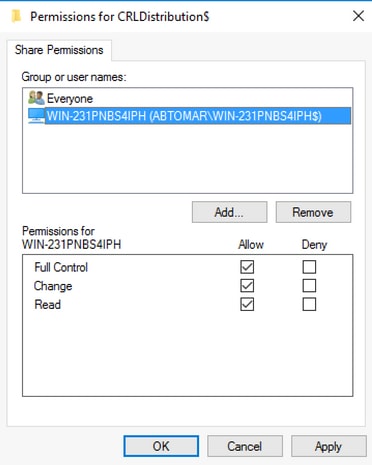
7. In order to allow the CA to write the CRL files to the new folder, configure the appropriate security permissions. Click the Security tab (1), click Edit (2), click Add (3), click Object Types (4), and check the Computers check box (5).
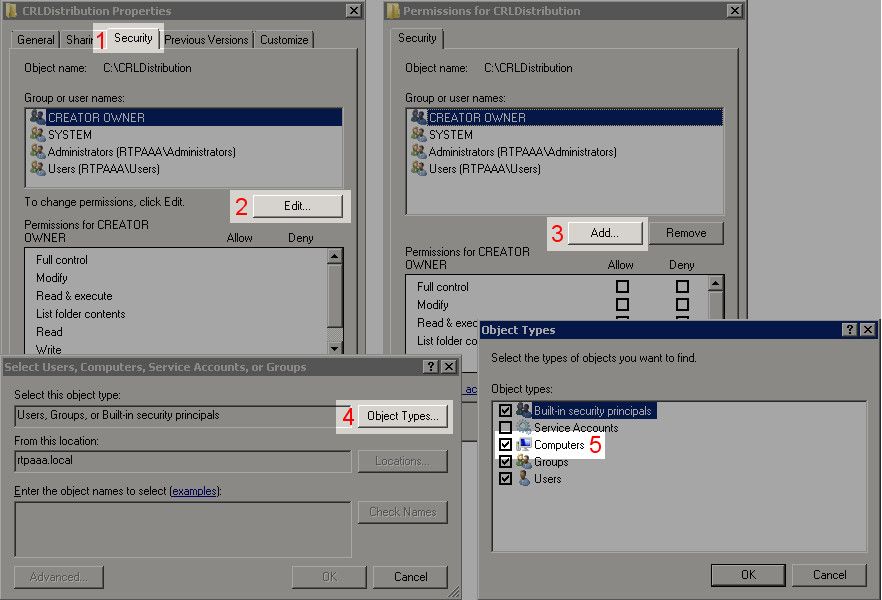
8. In the Enter the object names to select field, enter the computer name of the CA server, and click Check Names. If the name entered is valid, the name refreshes and appears underlined. Click OK.
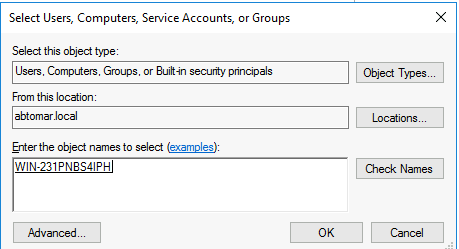
9. Choose the CA computer in the Group or user names field and then check to Allow for Full control to grant full access to the CA. Click OK and then click Close to complete the task.
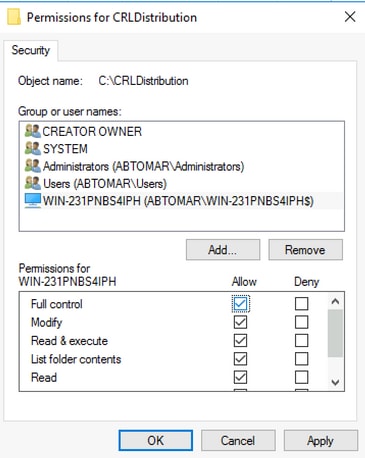
Create a Site in IIS to Expose the New CRL Distribution Point
In order for ISE to access the CRL files, make the directory that houses the CRL files accessible via IIS.
-
On the IIS server taskbar, click Start. Choose Administrative Tools > Internet Information Services (IIS) Manager.
-
In the left pane (known as the Console Tree), expand the IIS server name and then expand Sites.
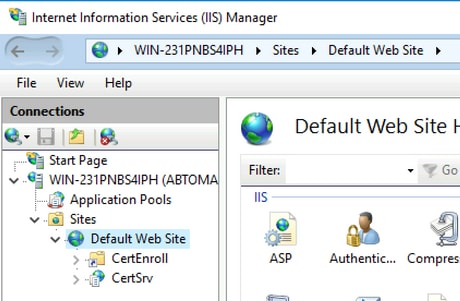
3. Right-click Default Web Site and choose Add Virtual Directory, as shown in this image.

4. In the Alias field, enter a site name for the CRL Distribution Point. In this example, CRLD is entered.
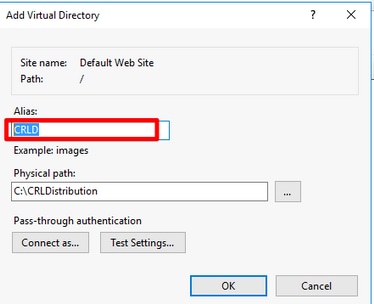
5. Click the ellipsis (. . .) to the right of the Physical path field and browse to the folder created in section 1. Select the folder and click OK. Click OK to close the Add Virtual Directory window.

6. The site name entered in step 4 must be highlighted in the left pane. If not, choose it now. In the center pane, double-click Directory Browsing.

7. In the right pane, click Enable to enable directory browsing.

8. In the left pane, choose the site name again. In the center pane, double-click Configuration Editor.
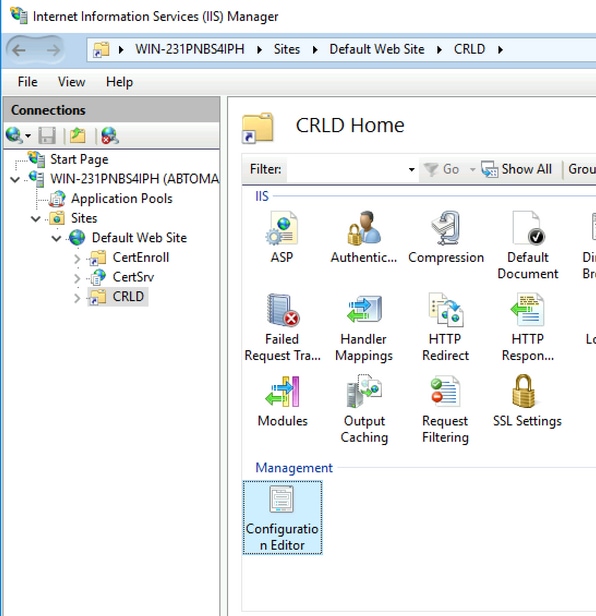
9. In the Section drop-down list, choose system.webServer/security/requestFiltering. In the allowDoubleEscaping drop-down list, choose True. In the right pane, click Apply, as shown in this image.

The folder must now be accessible via IIS.
Configure Microsoft CA Server to Publish CRL Files to the Distribution Point
Now that a new folder has been configured to house the CRL files and the folder has been exposed in IIS, configure the Microsoft CA server to publish the CRL files to the new location.
-
On the CA server taskbar, click Start. Choose Administrative Tools > Certificate Authority.
-
In the left pane, right-click the CA name. Choose Properties and then click the Extensions tab. In order to add a new CRL distribution point, click Add.

3. In the Location field, enter the path to the folder created and shared in section 1. In the example in section 1, the path is:
\\WIN-231PNBS4IPH\CRLDistribution$

4. With the Location field populated, choose <CaName> from the Variable drop-down list and then click Insert.

5. From the Variable drop-down list, choose <CRLNameSuffix> and then click Insert.

6. In the Location field, append .crl to the end of the path. In this example, the Location is:
\\WIN-231PNBS4IPH\CRLDistribution$\<CaName><CRLNameSuffix>.crl
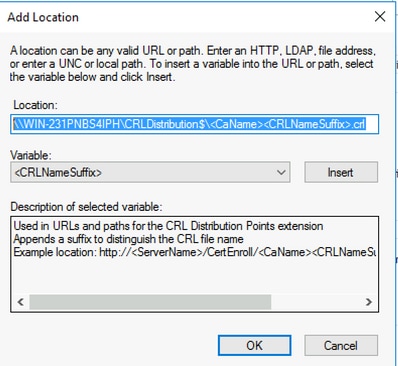
7. Click OK to return to the Extensions tab. Check the Publish CRLs to this location check box and then click OK to close the Properties window.
A prompt appears for permission to restart Active Directory Certificate Services. Click Yes.
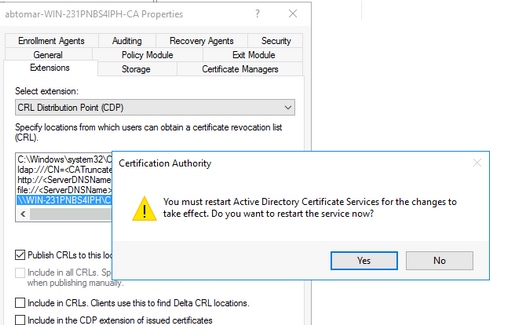
8. In the left pane, right-click Revoked Certificates. Choose All Tasks > Publish. Ensure that New CRL is selected and then click OK.


The Microsoft CA server must create a new .crl file in the folder created in section 1. If the new CRL file is created successfully there will be no dialog after OK is clicked. If an error is returned in regards to the new distribution point folder, carefully repeat each step in this section.
Verify the CRL File Exists and is Accessible via IIS
Verify the new CRL files exist and that they are accessible via IIS from another workstation before you start this section.
-
On the IIS server, open the folder created in section 1. There must be a single .crl file present with the form <CANAME>.crl where <CANAME> is the name of the CA server. In this example, the filename is:
abtomar-WIN-231PNBS4IPH-CA.crl

2. From a workstation on the network (ideally on the same network as the ISE primary Admin node), open a web browser and browse to http://<SERVER>/<CRLSITE> where <SERVER> is the server name of the IIS server configured in section 2 and <CRLSITE> is the site name chosen for the distribution point in section 2. In this example, the URL is:
http://win-231pnbs4iph/CRLD
The directory index displays, which includes the file observed in step 1.
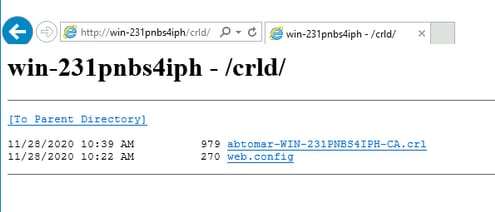
Configure ISE to use the New CRL Distribution Point
Before ISE is configured to retrieve the CRL, define the interval to publish the CRL. The strategy to determine this interval is beyond the scope of this document. The potential values (in Microsoft CA) are 1 hour to 411 years, inclusive. The default value is 1 week. Once an appropriate interval for your environment has been determined, set the interval with these instructions:
-
On the CA server taskbar, click Start. Choose Administrative Tools > Certificate Authority.
-
In the left pane, expand the CA. Right-click the Revoked Certificates folder and choose Properties.
-
In the CRL publication interval fields, enter the required number and choose the time period. Click OK to close the window and apply the change. In this example, a publication interval of 7 days is configured.

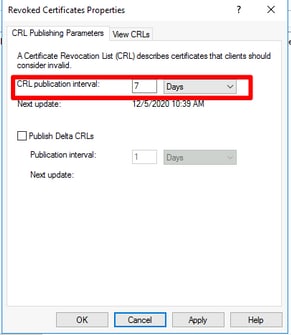
4. Enter the certutil -getreg CA\Clock* command to confirm the ClockSkew value. The default value is 10 minutes.
Example output:
Values: ClockSkewMinutes REG_DWORS = a (10) CertUtil: -getreg command completed successfully.
5. Enter the certutil -getreg CA\CRLov* command to verify whether the CRLOverlapPeriod has been manually set. By default the CRLOverlapUnit value is 0, which indicates that no manual value has been set. If the value is a value other than 0, record the value and units.
Example output:
Values: CRLOverlapPeriod REG_SZ = Hours CRLOverlapUnits REG_DWORD = 0 CertUtil: -getreg command completed successfully.
6. Enter the certutil -getreg CA\CRLpe* command to verify the CRLPeriod, which was set in step 3.
Example output:
Values: CRLPeriod REG_SZ = Days CRLUnits REG_DWORD = 7 CertUtil: -getreg command completed successfully.
7. Calculate the CRL Grace Period as follows:
a. If CRLOverlapPeriod was set in step 5: OVERLAP = CRLOverlapPeriod, in minutes;
Else: OVERLAP = (CRLPeriod / 10), in minutes
b. If OVERLAP > 720 then OVERLAP = 720
c. If OVERLAP < (1.5 * ClockSkewMinutes) then OVERLAP = (1.5 * ClockSkewMinutes)
d. If OVERLAP > CRLPeriod, in minutes then OVERLAP = CRLPeriod in minutes
e. Grace Period = OVERLAP + ClockSkewMinutes
Example: As stated above, CRLPeriod was set to 7 days, or 10248 minutes and CRLOverlapPeriod was not set.
a. OVERLAP = (10248 / 10) = 1024.8 minutes b. 1024.8 minutes is > 720 minutes : OVERLAP = 720 minutes c. 720 minutes is NOT < 15 minutes : OVERLAP = 720 minutes d. 720 minutes is NOT > 10248 minutes : OVERLAP = 720 minutes e. Grace Period = 720 minutes + 10 minutes = 730 minutes
The grace period calculated is the amount of time between when the CA publishes the next CRL and when the current CRL expires. ISE needs to be configured to retrieve the CRLs accordingly.
8. Log in to the ISE Primary Admin node and choose Administration > System > Certificates. In the left pane, select Trusted Certificate

9. Check the check box next to the CA certificate for which you intend to configure CRLs. Click Edit.
10. Near the bottom of the window, check the Download CRL check box.
11. In the CRL Distribution URL field, enter the path to the CRL Distribution Point, which includes the .crl file, created in section 2. In this example, the URL is:
http://win-231pnbs4iph/crld/abtomar-WIN-231PNBS4IPH-CA.crl
12. ISE can be configured to retrieve the CRL at regular intervals or based on the expiration (which, in general, is also a regular interval). When the CRL publish interval is static, more timely CRL updates are obtained when the latter option is used. Click the Automatically radio button.
13. Set the value for retrieval to a value less than the grace period calculated in step 7. If the value set is longer than the grace period, ISE checks the CRL distribution point before the CA has published the next CRL. In this example, the grace period is calculated to be 730 minutes, or 12 hours and 10 minutes. A value of 10 hours will be used for the retrieval
14. Set the retry interval as appropriate for your environment. If ISE cannot retrieve the CRL at the configured interval in the previous step, it will retry at this shorter interval.
15. Check the Bypass CRL Verification if CRL is not Received check box to allow certificate-based authentication to proceed normally (and without a CRL check) if ISE was unable to retrieve the CRL for this CA in its last download attempt. If this check box is not checked, all certificate-based authentication with certificates issued by this CA will fail if the CRL cannot be retrieved.
16. Check the Ignore that CRL is not yet valid or expired check box to allow ISE to use expired (or not yet valid) CRL files as though they were valid. If this check box is not checked, ISE considers a CRL to be invalid prior to their Effective Date and after their Next Update times. Click Save to complete the configuration.

1. Microsoft. "Configure a CRL Distribution Point for Certificates." http://technet.microsoft.com/en-us/library/ee649260%28v=ws.10%29.aspx, Oct. 7, 2009 [Dec 18, 2012]
2. Microsoft. "Manually publish the certificate revocation list." http://technet.microsoft.com/en-us/library/cc778151%28v=ws.10%29.aspx, Jan. 21, 2005 [Dec. 18, 2012]
3. Microsoft. "Configure CRL and Delta CRL Overlap Periods." http://technet.microsoft.com/en-us/library/cc731104.aspx, Apr. 11, 2011 [Dec 18, 2012]
4. MS2065 [MSFT]. "How EffectiveDate (thisupdate), NextUpdate and NextCRLPublish are calculated." http://blogs.technet.com/b/pki/archive/2008/06/05/how-effectivedate-thisupdate-nextupdate-and-nextcrlpublish-are-calculated.aspx, Jun. 4, 2008 [Dec 18, 2012]
Contributed by Cisco Engineers
- Abhishek TomarCisco TAC Engineer
- Justin TeixeiraCisco TAC Engineer
Contact Cisco
- Open a Support Case

- (Requires a Cisco Service Contract)
 Feedback
Feedback